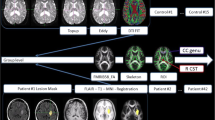Abstract
We examined T2 shortening in six children with infarcts due to moyamoya disease to clarify whether there are characteristic patterns of T2 shortening in the deep grey and white matter. Profound T2 shortening in the deep grey and white matter was observed in the acute stage of infarct in two cases, which changed to high intensity in the chronic stage; in this stage no T2 shortening was demonstrated in any case. Neither haemorrhagic infarction nor calcification was seen on CT or MRI. There could be longitudinally different T2 shortening patterns between infarcts due to moyamoya disease and other disorders.
Similar content being viewed by others
References
Haalegren B, Sourander P (1958) The effect of age on the non-haemin iron in the human brain. J Neurochem 3: 41–51
Aoki S, Okada Y, Nishimura K, Barkovich AJ, Kjos BO, Brasch RC, Norman D (1989) Normal deposition of brain iron in childhood and adolescence: MR imaging at 1.5 T. Radiology 172: 381–385
Drayer BP (1988) Imaging of the aging brain, part 1. Normal findings. Radiology 166: 785–796
Thomas LO, Boyko OB, Anthony DC, Burger PC (1993) MR detection of brain iron. AJNR 14: 1043–1048
Dietrich RB, Bradley WG (1988) Iron accumulation in the basal ganglia following severe ischemic-anoxic insults in children. Radiology 168: 203–206
Cross PA, Atlas SW, Grossman RI (1990) MR evaluation of brain iron in children with cerebral infarction. AJNR 11:341–348
Drayer B, Burger P, Hurwitz B, Dawson D, Cain J (1987) Reduced signal intensity on MR images of thalamus and putamen in multiple sclerosis: increased iron content? AJNR 8: 413–419
Drayer B, Olanow W, Burger P, Johnson GA, Herfkens R, Riederer S (1986) Parkinson's plus syndrome: diagnosis using high field imaging of brain iron. Radiology 159: 493–498
Rutledge JN, Hilal SK, Silver AJ, Defendini R, Fahn S (1987) Study of movement disorder and brain iron by MR. AJNR 8: 397–411
Park BE, Netsky MB, Betsill WL (1975) Pathogenesis of pigment and spheroid formation in Hallervorden-Spatz syndrome and related disorders. Neurology 25: 1172–1178
Takanashi J, Sugita K, Ishii M, Tanabe Y, Ito C, Date H, Niimi H (1993) Moyamoya syndrome in young children: MR comparison with adult onset. AJNR 14: 1139–1143
Suzuki J, Takaku A (1969) Cerebrovascular “moyamoya” disease: disease showing abnormal net-like vessels in base of brain. Arch Neurol 20: 288–299
Hill JM, Ruff MR, Weber RJ, Pert CB (1985) Transferrin receptors in rat brain: neuropeptide-like pattern and relationship to iron distribution. Proc Natl Acad Sci USA 82: 4553–4557
Jeffries WA, Brandon MR, Hunt SV, Williams AF, Gatter KC, Mason DY (1984) Transferrin receptor density on endothelium of brain capillaries. Nature 312: 162–163
Urich H (1976) Malformations of the nervous system, perinatal damage and related conditions in early life. In: Blackwood W, Corsellis JAN (eds) Greenfield's pathology. Arnold, London, p 434
Kim RC, Ramachandran T, Parisi JE, Collins GH (1981) Pallidonigral pigmentation and spheroid formation with multiple striatal lacunar infarcts. Neurology 31: 774–777
Ida M, Mizunuma K, Hata Y, Tada S (1994) Subcortical low intensity in early cortical ischemia. AJNR 15:1387–1393
Haimes AB, Zimmerman RD, Morgello S, Weingarten K, Becker RD, Jennis R, Deck MDF (1989) MR imaging of brain abscesses. AJNR 10: 279–291
Kudo T (1968) Spontaneous occlusion of the circle of Willis: a disease apparently confined to Japanese. Neurology 18:485–496
Nishimoto A, Takeuchi S (1968) Abnormal cerebrovascular network related to internal carotid arteries. J Neurosurg 29:223–230
Author information
Authors and Affiliations
Rights and permissions
About this article
Cite this article
Takanashi, J., Sugita, K., Tanabe, Y. et al. T2 shortening in childhood moyamoya disease. Neuroradiology 38 (Suppl 1), S169–S173 (1996). https://doi.org/10.1007/BF02278150
Received:
Accepted:
Issue Date:
DOI: https://doi.org/10.1007/BF02278150




